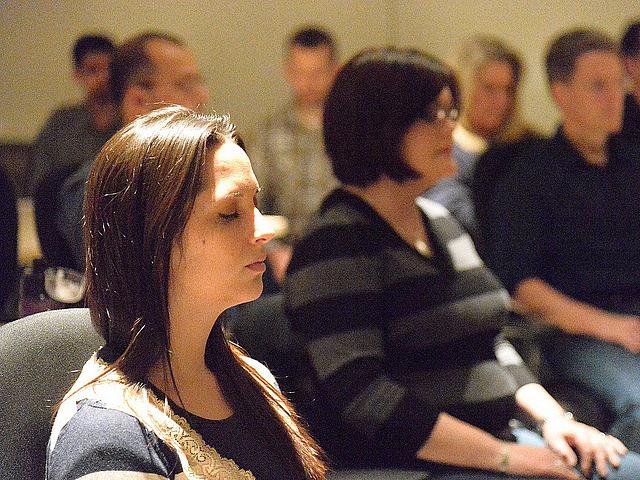For series on mindfulness, unconventional sources bolster credibility

My fellowship series was prompted by a question I’d been wondering about: Might mindfulness be a “prescription” for our health care system? I have heard from countless people, including many viewers of our newscast, who told me how meditating and yoga had changed their life. So why is it not commonly prescribed? And why do a lot of people think of it as useless or “hokie”? I knew it was something many San Diegans were preoccupied with because we see yoga and meditation centers on practically every street corner in our area.
Initially I interviewed a lot of people before the 2015 California Health Journalism Fellowship ever began. I had previously done a “wellness week” on San Diego 6 News. That's when I interviewed Deepak Chopra and a number of people from the Carlsbad-based Chopra Center who were highly supportive of mindfulness. They hooked my head up to a machine to show how meditation impacts the brain. I knew the topic was of interest to our viewers. I also knew a lot of the background already. But obviously, the fellowship series is a chance to dig deeper.
I discovered there is a large group of health professionals (even outside the Chopra Center) who want mindfulness to be a common recommendation from doctors, as with exercising and eating healthy. Advocates want everyone to meditate or practice yoga as a form of preventative health care. But that’s a long ways from happening. So I thought that evaluating the evidence from the military and medical communities would shed light on their mission. But I also wanted to see if there was anyone out there who opposed meditation. That last part was more difficult to find. If anyone is against it, they were not willing to go on camera to discuss it. I called around and asked but never really found the "negative" side to mindfulness.
I first looked into mindfulness practices within the military because I wanted to show there was even some governmental backing for the practice. The Naval Medical Center San Diego has a group of health professionals who want yoga and meditation to be part of all military members' routine. They believe this will help them before and after combat. I was able to get the personal accounts of quite a few people who explained how yoga helped calm their minds and ease their pain. Telling this story from a patient’s perspective made all the difference. You can hear statistics all day and listen to "officials" give their testimony, but if you don't have real people telling you about their real problems, then it's hard for viewers to become invested in your story. I wanted viewers to feel the pain of those interviewed, and understand their solutions.
I was surprised at how open the people I interviewed were. They shared with me information about their family life, injuries, mental health, and how yoga and meditation made them feel. It was also helpful to hear about their initial doubts. I think most people think of it as either too difficult to do or a waste of time. The passion from the military's medical team was also heard in their quotes, which I thought provided some rare emotional support from normally stoic subjects. I also incorporated results from some studies to support the claims, which I was able to find through PubMed, a great resource for finding relevant research.
My second piece was the most popular among our viewers. It gave a rare perspective from those in the medical community that meditate. You don't often hear about medical students and doctors taking the time out of their busy lives to sit still. But after many, many emails and requests (and months of waiting), I finally coordinated the interviews I needed. Medical students are now required to meditate at the University of California, San Diego. School was not in session while I was reporting, so I had to go through UCSD's Center for Mindfulness to finally reach a young woman who was doing a research project in San Diego during the summer. She shared with me her story of why she meditates and how she plans to tell her patients to do the same thing when she becomes a doctor. I learned from her that there is, in fact, a small shift within the medical community, with some new med students learning mindfulness. UCSD is not the only ones who adopting this practice; it's spreading to other universities as well. One of the doctors I featured was extremely helpful, sending photos of herself meditating. You always want to see your subjects "in action" to make it easier on the viewer to visualize what they're doing. It doesn't help to just hear them say it. Interviewing actual doctors on this topic was something I was unable to do before, so I think viewers also want to hear their professional opinions.
The mindfulness movement is gaining momentum. I think legislators may start to push for it as much as health professionals are starting to. Parents are also teaching their kids how to do it. So I will keep working on other angles for this topic and eventually incorporate all of it into a half-hour special. Getting military and medical professionals to open up about something that may not be the "norm" adds credibility, and you can only achieve that by asking a lot of questions and gaining their trust.
Find Neda Iranpour’s fellowship stories here.
[Photo by Intel Free Press via Flickr.]

